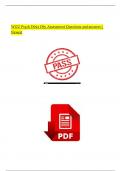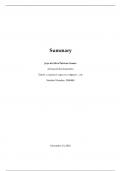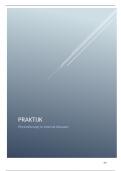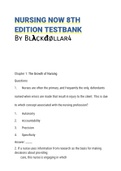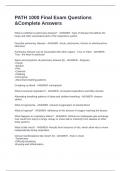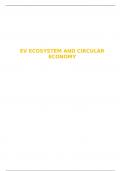WEEK 1 – COST OF CAPITAL
Today we’ll cover 4 learning objectives
What How
Determine the value of an investment NPV
opportunity (project / company)
Determine the right discount rate WACC
Calculate the return investors require given CAPM
the risk they take
Measure and interpret the risk of a security Beta
Determine the value of an investment opportunity (project / company) = NPV
How would you decide whether to invest in below project or not?
Investment
2017: -150mln
Cash flows
2018: 40mln
2019: 50mln
2020: 70mln
2021: 50mln
Discount rate
10%
Solution:
Determine the right discount rate = WACC
What is the “discount rate”?
Company perspective
I. Unilever’s cost of capital to finance the projects
Investor perspective
II. The required return of Unilver’s investors, given the risk taken
The discount rate represents both the cost of capital ánd the expected return given level of risk
What can a company do with excess cash?
What would a shareholder prefer?
1
,Discount rate bij all-equity financiering vs mix debt & equity
All Equity
A= 10
E= 10
→ CAPM: re=CAPM=rf+β(rm−rf)
Mix Debt & Equity
A= 10
D=4; E=6
What is WACC if:
𝒓debt =5%
𝒓equity = 12%
𝑻𝒄 = 21%
→ WACC
WACC= 𝐸/V ×𝑟equity+ 𝐷/V ×𝑟debt × (1−𝑇𝑐)
WACC Recipe
Step 1: calculate the weight of equity financing 𝐸 versus debt financing 𝐷 𝑉𝑉
E = market value of equity = # shares × price per share.
D = market value of debt. Note difference between MV and par value!
V = D + E.
Step 2: calculate the cost of debt and cost of equity
rdebt = Interest % on loan / YTM on bonds
requity=CAPM=rf+β(rm−rf) .
Step 3: input the above into the WACC formulaa
WACC= 𝐸/V ×𝑟equity+ 𝐷/V ×𝑟debt× (1−𝑇c)
Note: Tc = firm′s average tax rate.
WACC Old Exam Question
Given the following information, find the WACC. Assume the firm’s tax rate is 30%.
Debt: # 1,000, 4% coupon bonds outstanding, €1,000 par value, 20 years to maturity, selling for 103 per
cent of par; the bonds make semi-annual payments. The yield to maturity is 3.7%.
Equity: 30,000 shares outstanding, selling for 55 EUR per share; the cost of equity is 9.5%
MVD = 1,000(1000)(1.03) = 1,030,000
MVE = 30,000(55) = 1,650,000
Total market value of the firm is: 2,680,000
D/V = 38%
E/V = 62%
RD = YTM so 3.7%.
RE = 9.5%
WACC = 38%*3.7%*(1-0.3) + 62%*9.5% =6.8%
Calculate the return investors require given the risk they take = CAPM
The expected return on a stock can be determined with the CAPM
CAPM - Expected return on equity • 𝑅𝐸=𝑅𝐹+𝛽× 𝑅𝑀−𝑅𝐹
Contains 3 elements:
R𝐹 = 𝑟𝑖𝑠𝑘 − 𝑓𝑟𝑒𝑒 𝑟𝑎𝑡𝑒 → What is this? Compensation for...?
(𝑅𝑀 – 𝑅𝐹) =𝑚𝑎𝑟𝑘𝑒𝑡 𝑟𝑖𝑠𝑘 𝑝𝑟𝑒𝑚𝑖𝑢𝑚 → What is this? Compensation for...?
2
,𝛽 = 𝑠𝑦𝑠𝑡𝑒𝑚𝑎𝑡𝑖𝑐 𝑟𝑖𝑠𝑘 → What is this? Compensation for...?
Example CAPM Calculation
The return on the S&P 500 is 11%; the 3 months T-bill rate is 5%. What is the expected return for Stock X
that has a beta of 0.5?
CAPM:𝑅𝐸 =𝑅𝐹 +𝛽× (𝑅𝑀 −𝑅𝐹) = 5%+0.5(11%-5%)=8%
Measure and interpret the risk of a security = Beta
Beta measures the volatility—or systematic risk—of a stock compared to the market as a whole
What is beta?
Beta is the volatility of the return of the stock relative to the volatility of the return of the market.
A Beta greater than 1.0 suggests that the stock is more volatile than the broader market, and a beta less
than 1.0 indicates a stock with lower volatility.
Beta resembles the systematic risk, that cannot be diversified away.
How to estimate beta
With a formula:
𝛽 = 𝜌𝑗,m * (𝜎j/ 𝜎m)
With a regression:
𝛽 𝑈𝑛𝑖𝑙𝑒𝑣𝑒𝑟 = 0.72
Beta depends on business risk and financial risk
Business risk Financial risk
Cyclicity of Revenues Operating Leverage Financial Leverage
To what extend Fixed cost of production Fixed cost of financing as
performance is tied to high relative to total cost interest has to be paid
economic cycles regardless of income
0.47 – 1.02 1.34 – 0.7 0.9 - 1.1
Five points to beware of when it comes to Beta
1. Beta is not the same as the Correlation Coëfficiënt
2. Beta’s have a realistic rather than a fixed range
3. Beta’s are not “Set in stone”
4. There is a difference between the Asset Beta and the Equity Beta
5. A project Beta can be different from the firm’s Beta
There is a difference between the Asset Beta and the Equity Beta
Difference asset beta vs equity beta o The degree of financial leverage
The asset beta (“unlevered beta”) magnifies the riskiness of the
measures the riskiness of the firm’s assets assets for the stockholders
o Depends on the business risk (i.e. Formula asset beta vs equity beta
the cyclicality of revenues and the An individual owns the entire firm. What is
degree of operating leverage) the beta of this portfolio?
The equity beta (“levered beta”) measures As with any portfolio, the beta of this
the riskiness of the firm’s assets for the portfolio is a weighted average of the
shareholders betas of the individual items in the
portfolio
𝛽A =𝐸/V × 𝛽E + D/V x 𝛽D
3
, common assumption 𝛽D=0 => 𝛽E= 𝛽A x E/V = 𝛽A x (1+D/E)
𝛽A =E/V x 𝛽E
With taxes multiple by (1-Tc)
WEEK 2 –CAPITAL STRUCTURE
What do we know so far?
ü The cost of capital is important: Lowering the cost of capital is one way to increase the market value of
a firm.
ü The firm’s cost of capital is impacted by its debt-equity mix.
ü Increasing the leverage (i.e., the amount of debt) increases the systematic risk of equity and hence the
cost of equity.
Debt and firm value example 1
Suppose the market value of J.J. Sprint plc is £1,000.
The company currently has no debt, and each of J.J. Sprint's 100 shares sells for £10.
Further suppose that J.J. Sprint plans to borrow £500 and pay the £500 proceeds to shareholders as an
extra cash dividend of £5 per share.
The investments of the firm will not change as a result of this transaction. What will the value of the firm be
after the proposed restructuring?
Management recognizes that, by definition, only one of three outcomes can occur from restructuring.
Firm value after restructuring can be
greater than the original firm value of £1,000,
equal to £1,000, or
less than £1,000.
After consulting with investment bankers, management believes that restructuring will not change firm
value more than £250 in either direction. Thus it views firm values of £1,250, £1,000 and £750 as the
relevant range.
Management recognizes that there are infinite possible outcomes. These three are to be viewed as
representative outcomes only.
Value of Debt Plus Equity after Payment of Dividend (3
No Debt Possibilities)
(Original Capital Structure, £)
I (£) II (£) III (£)
Debt 0 500 500 500
Equity 1,000 750 500 250
Firm
1,000 1,250 1,000 750
value
Pay-off to shareholders
Pay-off to Shareholders after Restructuring
I (£) II (£) III (£)
4
Today we’ll cover 4 learning objectives
What How
Determine the value of an investment NPV
opportunity (project / company)
Determine the right discount rate WACC
Calculate the return investors require given CAPM
the risk they take
Measure and interpret the risk of a security Beta
Determine the value of an investment opportunity (project / company) = NPV
How would you decide whether to invest in below project or not?
Investment
2017: -150mln
Cash flows
2018: 40mln
2019: 50mln
2020: 70mln
2021: 50mln
Discount rate
10%
Solution:
Determine the right discount rate = WACC
What is the “discount rate”?
Company perspective
I. Unilever’s cost of capital to finance the projects
Investor perspective
II. The required return of Unilver’s investors, given the risk taken
The discount rate represents both the cost of capital ánd the expected return given level of risk
What can a company do with excess cash?
What would a shareholder prefer?
1
,Discount rate bij all-equity financiering vs mix debt & equity
All Equity
A= 10
E= 10
→ CAPM: re=CAPM=rf+β(rm−rf)
Mix Debt & Equity
A= 10
D=4; E=6
What is WACC if:
𝒓debt =5%
𝒓equity = 12%
𝑻𝒄 = 21%
→ WACC
WACC= 𝐸/V ×𝑟equity+ 𝐷/V ×𝑟debt × (1−𝑇𝑐)
WACC Recipe
Step 1: calculate the weight of equity financing 𝐸 versus debt financing 𝐷 𝑉𝑉
E = market value of equity = # shares × price per share.
D = market value of debt. Note difference between MV and par value!
V = D + E.
Step 2: calculate the cost of debt and cost of equity
rdebt = Interest % on loan / YTM on bonds
requity=CAPM=rf+β(rm−rf) .
Step 3: input the above into the WACC formulaa
WACC= 𝐸/V ×𝑟equity+ 𝐷/V ×𝑟debt× (1−𝑇c)
Note: Tc = firm′s average tax rate.
WACC Old Exam Question
Given the following information, find the WACC. Assume the firm’s tax rate is 30%.
Debt: # 1,000, 4% coupon bonds outstanding, €1,000 par value, 20 years to maturity, selling for 103 per
cent of par; the bonds make semi-annual payments. The yield to maturity is 3.7%.
Equity: 30,000 shares outstanding, selling for 55 EUR per share; the cost of equity is 9.5%
MVD = 1,000(1000)(1.03) = 1,030,000
MVE = 30,000(55) = 1,650,000
Total market value of the firm is: 2,680,000
D/V = 38%
E/V = 62%
RD = YTM so 3.7%.
RE = 9.5%
WACC = 38%*3.7%*(1-0.3) + 62%*9.5% =6.8%
Calculate the return investors require given the risk they take = CAPM
The expected return on a stock can be determined with the CAPM
CAPM - Expected return on equity • 𝑅𝐸=𝑅𝐹+𝛽× 𝑅𝑀−𝑅𝐹
Contains 3 elements:
R𝐹 = 𝑟𝑖𝑠𝑘 − 𝑓𝑟𝑒𝑒 𝑟𝑎𝑡𝑒 → What is this? Compensation for...?
(𝑅𝑀 – 𝑅𝐹) =𝑚𝑎𝑟𝑘𝑒𝑡 𝑟𝑖𝑠𝑘 𝑝𝑟𝑒𝑚𝑖𝑢𝑚 → What is this? Compensation for...?
2
,𝛽 = 𝑠𝑦𝑠𝑡𝑒𝑚𝑎𝑡𝑖𝑐 𝑟𝑖𝑠𝑘 → What is this? Compensation for...?
Example CAPM Calculation
The return on the S&P 500 is 11%; the 3 months T-bill rate is 5%. What is the expected return for Stock X
that has a beta of 0.5?
CAPM:𝑅𝐸 =𝑅𝐹 +𝛽× (𝑅𝑀 −𝑅𝐹) = 5%+0.5(11%-5%)=8%
Measure and interpret the risk of a security = Beta
Beta measures the volatility—or systematic risk—of a stock compared to the market as a whole
What is beta?
Beta is the volatility of the return of the stock relative to the volatility of the return of the market.
A Beta greater than 1.0 suggests that the stock is more volatile than the broader market, and a beta less
than 1.0 indicates a stock with lower volatility.
Beta resembles the systematic risk, that cannot be diversified away.
How to estimate beta
With a formula:
𝛽 = 𝜌𝑗,m * (𝜎j/ 𝜎m)
With a regression:
𝛽 𝑈𝑛𝑖𝑙𝑒𝑣𝑒𝑟 = 0.72
Beta depends on business risk and financial risk
Business risk Financial risk
Cyclicity of Revenues Operating Leverage Financial Leverage
To what extend Fixed cost of production Fixed cost of financing as
performance is tied to high relative to total cost interest has to be paid
economic cycles regardless of income
0.47 – 1.02 1.34 – 0.7 0.9 - 1.1
Five points to beware of when it comes to Beta
1. Beta is not the same as the Correlation Coëfficiënt
2. Beta’s have a realistic rather than a fixed range
3. Beta’s are not “Set in stone”
4. There is a difference between the Asset Beta and the Equity Beta
5. A project Beta can be different from the firm’s Beta
There is a difference between the Asset Beta and the Equity Beta
Difference asset beta vs equity beta o The degree of financial leverage
The asset beta (“unlevered beta”) magnifies the riskiness of the
measures the riskiness of the firm’s assets assets for the stockholders
o Depends on the business risk (i.e. Formula asset beta vs equity beta
the cyclicality of revenues and the An individual owns the entire firm. What is
degree of operating leverage) the beta of this portfolio?
The equity beta (“levered beta”) measures As with any portfolio, the beta of this
the riskiness of the firm’s assets for the portfolio is a weighted average of the
shareholders betas of the individual items in the
portfolio
𝛽A =𝐸/V × 𝛽E + D/V x 𝛽D
3
, common assumption 𝛽D=0 => 𝛽E= 𝛽A x E/V = 𝛽A x (1+D/E)
𝛽A =E/V x 𝛽E
With taxes multiple by (1-Tc)
WEEK 2 –CAPITAL STRUCTURE
What do we know so far?
ü The cost of capital is important: Lowering the cost of capital is one way to increase the market value of
a firm.
ü The firm’s cost of capital is impacted by its debt-equity mix.
ü Increasing the leverage (i.e., the amount of debt) increases the systematic risk of equity and hence the
cost of equity.
Debt and firm value example 1
Suppose the market value of J.J. Sprint plc is £1,000.
The company currently has no debt, and each of J.J. Sprint's 100 shares sells for £10.
Further suppose that J.J. Sprint plans to borrow £500 and pay the £500 proceeds to shareholders as an
extra cash dividend of £5 per share.
The investments of the firm will not change as a result of this transaction. What will the value of the firm be
after the proposed restructuring?
Management recognizes that, by definition, only one of three outcomes can occur from restructuring.
Firm value after restructuring can be
greater than the original firm value of £1,000,
equal to £1,000, or
less than £1,000.
After consulting with investment bankers, management believes that restructuring will not change firm
value more than £250 in either direction. Thus it views firm values of £1,250, £1,000 and £750 as the
relevant range.
Management recognizes that there are infinite possible outcomes. These three are to be viewed as
representative outcomes only.
Value of Debt Plus Equity after Payment of Dividend (3
No Debt Possibilities)
(Original Capital Structure, £)
I (£) II (£) III (£)
Debt 0 500 500 500
Equity 1,000 750 500 250
Firm
1,000 1,250 1,000 750
value
Pay-off to shareholders
Pay-off to Shareholders after Restructuring
I (£) II (£) III (£)
4

